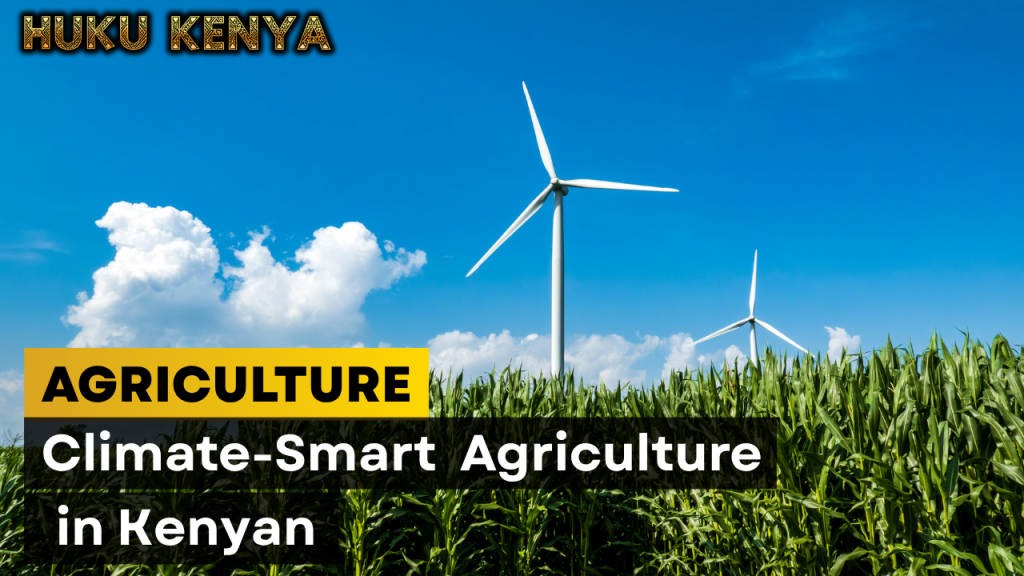Adapting to a Changing Climate

As Kenya grapples with the impacts of climate change, the concept of climate-smart agriculture (CSA) has emerged as a vital strategy to enhance food security, increase resilience, and reduce greenhouse gas emissions. CSA focuses on sustainable agricultural practices that adapt to changing climatic conditions while ensuring productivity and environmental sustainability. This article delves into the principles of climate-smart agriculture, emphasizing climate change adaptation, drought-resistant crops, irrigation systems, water conservation, and agroecology.
1. Understanding Climate-Smart Agriculture
Overview
Climate-smart agriculture is an integrated approach that aims to improve agricultural productivity and resilience in the face of climate change. It seeks to achieve three main objectives:
- Increase Productivity: Enhance food security by increasing agricultural yields.
- Enhance Resilience: Improve the ability of farming systems to withstand climate-related shocks.
- Reduce Emissions: Mitigate greenhouse gas emissions associated with agricultural practices.
Importance in Kenya
In Kenya, where agriculture is a key driver of the economy, climate-smart agriculture is critical for addressing challenges such as drought, soil degradation, and erratic rainfall patterns. With over 75% of the population relying on agriculture for their livelihoods, adopting climate-smart practices is essential for long-term sustainability.
2. Climate Change Adaptation
Overview
Climate change adaptation involves adjusting agricultural practices to minimize the negative impacts of climate variability. In Kenya, this is crucial as farmers face increasing unpredictability in weather patterns.
Strategies for Adaptation
a. Crop Diversification
Diversifying crops can enhance resilience by spreading risk. By planting a variety of crops, farmers can better withstand pests, diseases, and varying climatic conditions. For instance, incorporating indigenous and drought-resistant crops can provide food security during dry spells.
b. Early Warning Systems
Implementing early warning systems for weather forecasting can help farmers prepare for adverse weather conditions. Access to timely information allows farmers to make informed decisions about planting and harvesting.
c. Agroforestry
Integrating trees into agricultural landscapes can enhance resilience. Trees provide shade, reduce soil erosion, and improve biodiversity, creating a more stable environment for crops.
3. Drought-Resistant Crops
Overview
Drought-resistant crops are essential for mitigating the impacts of climate change, especially in arid and semi-arid regions of Kenya. These crops are bred or selected for their ability to withstand prolonged dry conditions.
Benefits of Drought-Resistant Crops
- Food Security: Drought-resistant varieties ensure a stable food supply even during dry seasons.
- Resource Efficiency: These crops typically use water more efficiently, reducing the strain on limited water resources.
- Economic Stability: Farmers growing drought-resistant crops are less vulnerable to crop failure, leading to more stable incomes.
Examples of Drought-Resistant Crops
- Sorghum: This grain is well-suited for arid conditions and provides a nutritious food source.
- Millet: Known for its resilience, millet requires less water and can thrive in poor soil conditions.
- Cowpeas: A drought-tolerant legume that enriches the soil while providing protein-rich food.
4. Irrigation Systems
Overview
Efficient irrigation systems are critical for climate-smart agriculture, particularly in regions where rainfall is insufficient or unpredictable. Effective irrigation can enhance productivity and conserve water resources.
Types of Irrigation Systems
a. Drip Irrigation
Drip irrigation delivers water directly to the plant roots, minimizing evaporation and runoff. This system is highly efficient and can significantly reduce water usage while increasing crop yields.
b. Sprinkler Irrigation
Sprinkler systems distribute water through a network of pipes and can cover larger areas. While they are effective, they require more energy and can lead to evaporation losses if not managed properly.
c. Rainwater Harvesting
Collecting and storing rainwater for agricultural use is an effective way to enhance water availability. Rainwater harvesting systems can provide farmers with a reliable water source during dry periods.
Benefits of Irrigation
- Increased Yields: Access to irrigation allows farmers to cultivate more crops and achieve higher yields.
- Crop Diversification: Irrigation enables the growth of a wider variety of crops, contributing to food security.
- Mitigation of Drought Impacts: With reliable water sources, farmers can better cope with drought conditions.
5. Water Conservation
Overview
Water conservation is a key component of climate-smart agriculture, especially in water-scarce regions. Implementing water-saving practices can enhance resilience and ensure sustainable water use.
Strategies for Water Conservation
a. Soil Moisture Management
Practices such as mulching, cover cropping, and conservation tillage help retain soil moisture, reducing the need for irrigation. This is particularly important during dry spells when water is scarce.
b. Efficient Water Use
Farmers can adopt practices that optimize water use, such as scheduling irrigation based on weather forecasts and soil moisture levels. Using moisture sensors can help determine when and how much to irrigate.
c. Community-Based Water Management
Promoting community involvement in water resource management ensures equitable access and sustainable use of water resources. This can involve the construction of community ponds, dams, or shared irrigation systems.
6. Agroecology
Overview
Agroecology is an approach that combines ecological principles with agricultural practices to create sustainable farming systems. It emphasizes biodiversity, local knowledge, and sustainable resource management.
Key Principles of Agroecology
- Biodiversity Enhancement: Promoting a diverse range of crops, livestock, and species to improve resilience and productivity.
- Synergy: Creating beneficial interactions between different components of the agricultural system, such as integrating crops with livestock.
- Sustainable Practices: Utilizing practices that preserve natural resources, such as organic farming and agroforestry.
Benefits of Agroecology in Kenya
- Improved Soil Health: Agroecological practices enhance soil structure and fertility, leading to more productive farming systems.
- Resilience to Climate Change: Diverse agroecosystems are better equipped to withstand climate variability and shocks.
- Empowerment of Local Communities: Agroecology encourages local knowledge and practices, empowering communities to manage their resources sustainably.
7. Challenges and Opportunities
Challenges
Despite the promise of climate-smart agriculture, several challenges hinder its implementation in Kenya:
- Limited Awareness: Many farmers are unaware of climate-smart practices and their benefits.
- Access to Resources: Financial constraints and lack of access to technology can impede the adoption of innovative practices.
- Policy Gaps: Insufficient government support and policies can limit the scalability of climate-smart initiatives.
Opportunities
Fortunately, there are several opportunities for promoting climate-smart agriculture in Kenya:
- Government Initiatives: Increasing government recognition of climate-smart agriculture can lead to supportive policies and funding.
- Research and Development: Investments in research can drive innovation in climate-smart practices and technologies.
- Partnerships: Collaborations between governments, NGOs, and the private sector can facilitate knowledge sharing and resource mobilization.
8. The Way Forward
To effectively promote climate-smart agriculture in Kenya, a multi-faceted approach is essential:
- Education and Training: Expanding training programs for farmers on climate-smart practices will empower them to adopt sustainable methods.
- Investment in Infrastructure: Improving irrigation and water management infrastructure is critical for supporting farmers in adopting climate-smart practices.
- Community Engagement: Involving local communities in decision-making processes ensures that practices are culturally appropriate and effective.
Conclusion
Climate-smart agriculture presents a promising pathway for Kenya to address the challenges posed by climate change while ensuring food security and sustainable livelihoods. By embracing strategies such as climate change adaptation, drought-resistant crops, efficient irrigation systems, water conservation, and agroecology, Kenyan farmers can build resilient agricultural systems.
As the effects of climate change continue to unfold, the adoption of climate-smart practices will be essential for safeguarding the future of agriculture in Kenya. Through collaboration, innovation, and commitment to sustainability, Kenya can lead the way in climate-smart agriculture, ensuring a more resilient and food-secure future for all.

























